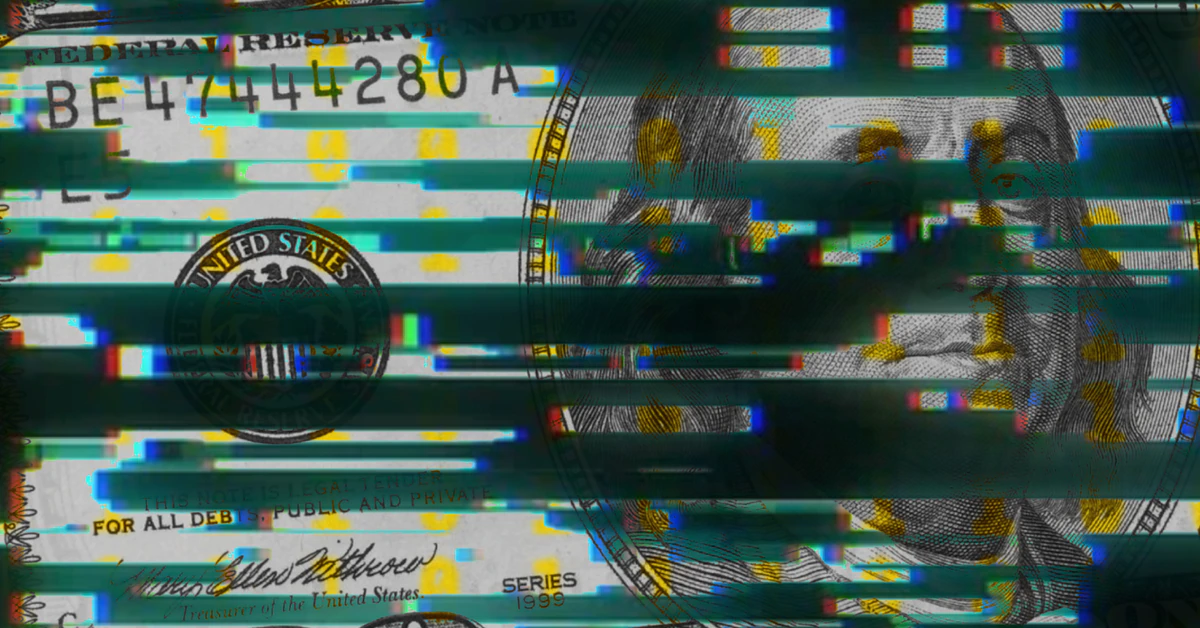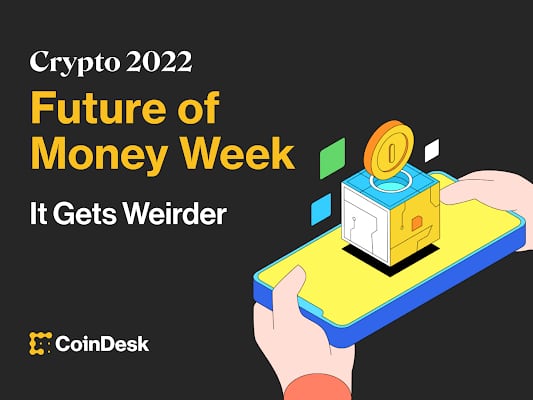Some predictions about the future of money are cautious, sensible, sober and grounded. These are not. To open our minds as to what the future might bring, we chucked the usual concepts like “most likely” or “bet on this.” Instead we wondered, what are some dark horse scenarios that maybe, just maybe, could revolutionize the way we think about money?
Here the focus is more on fun than functional, more possible than probable. Then again, we now live in a world where cartoon apes sell for $2.6 million, memes about dogs are worth billions, and a sovereign nation accepts bitcoin as legal tender.
Anything is in play.
This article is part of Future of Money Week, a series exploring the varied (and sometimes weird) ways value will move in the future.
1. Risk becomes tokenized
What if we could tokenize risk? If we do this in a clever way, we could reduce the overall risk in the system and avoid meltdowns like the financial crisis of 2008, says Ashleigh Schap, a decentralized finance (DeFi) investor and adviser at Uniswap, a decentralized trading platform.
Here’s how to think about it. Imagine if you, as an individual, have tokens that represent each of your risks and liabilities. A token for your car loan. A token for your home mortgage. A token for your leveraged margin trading account. If you roll up all of your individual risk tokens, that would give you a sense of your total risk.
Now zoom out the lens. Imagine aggregating all of the risk tokens by each person in the community, and then an entire industry, or even the entire economy. Because these tokens are all smart contracts – programmable money – this would let you “build risk into the system in a more fundamental way,” says Schap.
She contrasts this to the constraints of traditional finance, most famously in the collapse of 2008, where each company had its own siloed view of risk but they lacked a holistic picture of the overall risk to the system. By tokenizing risk? You can snap all the puzzle pieces together, and “smart contracts can basically assess the entire picture.”
Read more: The Future of Money: 20 Predictions
2. Cars spend money and buy their own insurance
Way back in February of this year, Elizabeth Stark, head of Lightning Labs, gave me this prediction: “Machines will pay machines, natively, instantly … Teslas will pay for charging with Lightning!”
That’s just one example. The possibilities are endless. “Imagine a machine at a factory, if it runs out of ink, it can order more,” says Schap. She then gives a spicier scenario. “Maybe you have a car or a truck that’s able to buy its own insurance,” she says. Perhaps the car has the ability to assess risk and make smart decisions. “If it’s raining, it buys a little more insurance,” says Schap.
She notes that in our current world, whenever you buy car insurance, “you’re paying for the insurance every day, even when you’re not driving the car.” You have a busy life. You don’t have time to deal with insurance companies every month, much less every day. But imagine if the car could constantly survey the risks – weather, traffic conditions, even neighborhood – and make constant tweaks to your insurance? (Just before it becomes fully sentient and dominates the world.)
3. You will pay for things without thinking about it at all
This could be here sooner than you think. A couple of weeks ago, I went to a Denver Broncos football game. The stadium had a beer stand that looks teleported from the future: First you scan your credit card, then you go through a turnstile to enter a room full of coolers. You take whatever beer you want, then you leave. No scanning of UPC codes. No interacting with any humans. As the attendant explained to me, an elaborate network of cameras and GPS micro-sensors ensures that you are charged for the correct number of beers.
Tarun Chitra, CEO and co-founder of Gauntlet and General Partner at Robot Ventures, imagines a shopping experience like this in the future but without credit cards, wallets or even phones. It will be driven by cryptocurrency and stablecoins – not a centralized player like Amazon – and somehow it protects privacy. “You go pick up your items and walk out,” says Chitra. You have an agreement with the grocery store, for example, where “you can automatically charge me if it’s less than $100.”
Read more: The Future of Money: A History – Dan Jeffries
4. The price of your dinner will be in sats
The idea of “buying a coffee with bitcoin” is now something of a punchline, at least in developed economies like the United States. But it will happen eventually, says Cory Klippsten, founder of Swan Bitcoin (and author of an op-ed for this “Future of Money” series). “The medium of exchange for bitcoin will not take off,” says Klippsten, “until a lot of people hold the majority of their net worth in bitcoin.” His logic? It makes no sense to spend your bitcoin “unless you have nothing else to spend.” And he thinks this scenario is inevitable.
“Nobody wants to spend bitcoin. It’s the best risk-to-reward bet in history,” says Klippsten. And yet. As a bit of foreshadowing for what the mainstream world could look like, he points to the precedent of OG bitcoiners who have the majority of their assets in BTC. They got rich off bitcoin. They HODLed their bitcoin. But at some point, inevitably, when push comes to shove, they need to spend at least some of their BTC to do things like buy a car or a yacht.
Klippsten predicts that bitcoin as a store of value will become so widespread, and so ubiquitous, that eventually people will need to spend their assets. He imagines a chart with two “S curves”: one for the adoption of bitcoin as a store of value and then one with bitcoin as medium of exchange. (S curve: It starts out gradual and flat, then dramatically shoots up, then goes flat again.) “We’re still on the flat part of the S curve for store of value,” he says, and when that skyrockets, people will then hop over to the medium of exchange S curve. He scribbles out a quick drawing on our call, and literally two hours after we spoke, he formalized the graphic and tweeted the following:
Most people don't spend #Bitcoin till they have nothing else to spend. That's why the Medium Of Exchange adoption curve lags the Store Of Value adoption curve.By 2035 you'll be able to buy most goods and services in most places around the world denominated in sats. pic.twitter.com/pLThgheabe
— Cory Swan.com (@coryklippsten) November 17, 2021
The upshot of all this? “By 2035, most goods and services in most places in the world will be denominated in Satoshis,” says Klippsten. He clarifies that the dollar and other fiat currencies will still likely exist, which means that you might see multiple prices on items, just like you do at international airports. The implication, of course, is that the price of BTC would soar in value. Klippsten’s guess: “The chance of bitcoin being less than $1 million in nine years is infinitesimally small.”
5. Tokens make cash go away
First, imagine a world where tokens are ubiquitous. As Jeff Dorman, chief investment officer at Arca, envisions in CoinDesk’s 20 Predictions, “I believe every company in the world will have a token in its capital structure in the next five-to-ten years.” These tokens are hybrids. They’re part quasi-equity, part loyalty program, and they’ll grow in value if the company becomes more valuable.
Then he takes the logic one step further. “We’ll also begin to see the digitization of illiquid real-world assets, like your home equity, your car, and your jewelry, as well as tokens that represent future liabilities like university tuition tokens and health care tokens.”
Here’s the kicker. Once every asset becomes digitized and liquid, says Dorman, “You’ll never need to own cash ever again. You’ll be able to stay 100% invested at all times, borrow against your assets as needed, and pay for common goods using your investments since they will be spendable blockchain-based assets. By bridging the gap between investment vehicle and payment vehicle, digital assets will ultimately eliminate the need for an asset that functions purely as money.”
Read more: Who Sets the Rules of Bitcoin as Nation-States and Corps Roll In – David Z. Morris
6. Your house is a bank
This is an offshoot of the “cars can buy insurance” scenario, with a twist. If you’ve been in crypto for more than five minutes, you’ve heard the phrase “be your own bank.” But Chitra wonders, what if your house could be its own bank? Or your car? He notes that in the crypto world, thanks to the magic of liquidity pools in DeFi, “everyone can be a lender if they want to be.”
Not only could everyone be a lender but potentially everything. “It could be the IoT [Internet of Things] device, it could be your car, whatever, it could be a building.” In today’s world, using something like a Real Estate Investment Trust (REIT) to borrow against your building is a manual, tedious, torturous process that involves lots of banking. “That will become almost instant,” says Chitra, “as every building can become its own bank.”
And in the true spirit of this exercise, Chitra lobs another thought experiment: “The richest entity of the world becomes a broken Tesla.” The Tesla breaks, it can’t work and it can’t earn fees in the future where it gets paid for being an Uber. In the process, the Tesla somehow realizes that “the only thing it can do with its money is trade.” Because the broken Tesla can’t do anything else, it slowly learns to trade, it excels, it becomes a super trader, and “you have this rags to riches story.”
Think that scenario is out there? Buckle up for the final one.
7. Money goes intergalactic
“Galaxy Brain” doesn’t do this scenario justice. It is literally inter-galaxy brain. Schap clarifies that this scenario is far, far, far out in the future, but thinks that “assuming we continue to develop technologically, and if we manage to become space navigators – and we’re headed in that direction – money will need to change, because time will change.” She then suggests an idea inspired by the sci-fi novel “Neptune’s Brood,” from Charles Stross.
If we’re trying to travel to another galaxy that’s 400 light years away, as Schap explains, “money will mean something very different when you get to that very faraway place.” Decades, centuries, or millennia might pass while you make the journey from Earth to another corner of the universe. What if money could somehow incorporate properties that would account for these dramatic changes in time?
“I think you’ll have difference classes of money,” says Schap. “You’ll have immediate money that you’ll spend on a planet.” Then there’s “medium-term” money, which would be “useful somewhere in our galaxy.” The final class is what Schap calls long-term “slow money,” which “is much more valuable, but the reason is slow is that it has to move across space and time in an interesting way.”
Coming soon, on Coinbase.






